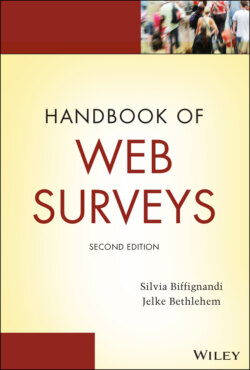Читать книгу Handbook of Web Surveys - Jelke Bethlehem - Страница 14
EXAMPLE 1.2 The first telephone survey in the Netherlands
ОглавлениеThe first telephone survey took place in the Netherlands on June 11, 1946. See NIPO (1946) for a detailed description. An interview to a few hundred owners of telephones in Amsterdam asked a few questions about listening to the radio. The call to the people was between 20:00 and 21:30 hours on a Tuesday night. Some results are in Table 1.1.
Table 1.1 The first telephone survey in the Netherlands
| Are you listening to the radio at this moment? | Percentage |
|---|---|
| Was listening | 24 |
| Was not listening | 38 |
| Line busy | 5 |
| No answer | 31 |
| Did not have a radio | 2 |
If people declared they were listening to the radio, the program they were listening to was asked. It turned out that 85% was listening the “Bonte Dinsdagavondtrein,” a very famous radio show at that time.
Telephone interviewing has some limitations. Interviews cannot last too long, and no written answer is possible. Obviously, no show cards are used; lists are read loud (by the interviewers).
This implies a possible recency effect in the answers. Another problem may be the lack of a proper sampling frame. Telephone directories may suffer from severe under‐coverage because many people do not want their phone number is in the directory. Another new development is that increasingly people replace their landline phone by a mobile phone. This fact increases under‐coverage in the telephone directories. For example, according to Cobben and Bethlehem (2005), only between 60% and 70% of the Dutch population had at that time a telephone dictionary.
A way to avoid the under‐coverage problems of telephone directories is to apply random digit dialing (RDD) to generate random phone numbers. A computer algorithm computes valid random telephone numbers. Such an algorithm is able to generate both listed and unlisted numbers. Thus, there is complete coverage. An example of an algorithm used in the United Kingdom is to take a number from a directory and replace its last digit by a random digit. RDD also has drawbacks. In some country it is not clear what an unanswered number means. It can mean that the number is not in use. This is a case of over‐coverage. No follow‐up is needed. It can also mean that someone simply does not answer the phone, which is a case of nonresponse, which has to be followed up. Another drawback of RDD is that there is no information at all about nonrespondents. This makes correction for nonresponse very difficult (Bethlehem, Cobben, and Schouten (2011), see also Chapter 12).
The choice of the mode of data collection is not any easy one. It is usually a compromise between quality and costs. In large countries (like the United States) or sparsely populated countries (like Sweden), it is almost impossible to collect survey data by means of face‐to‐face interviewing. It requires so many interviewers that have to do so much traveling that the costs would be very high. Therefore, it is not surprising that telephone interviewing emerged here as a major data collection mode. In a very small and densely populated country, like the Netherlands, face‐to‐face interviewing is much more attractive. Coverage problems of telephone directories and low response rates also play a role in the choice for face‐to‐face interviewing. More about data collection issues is in Couper et al. (1998).
